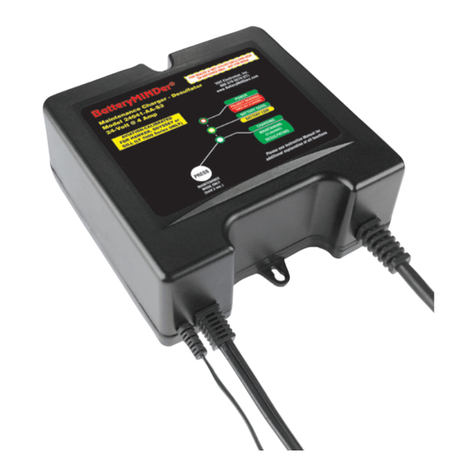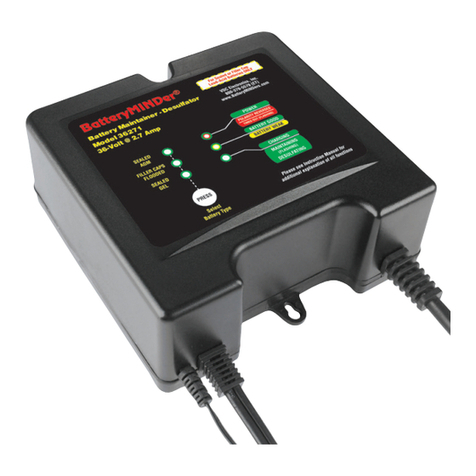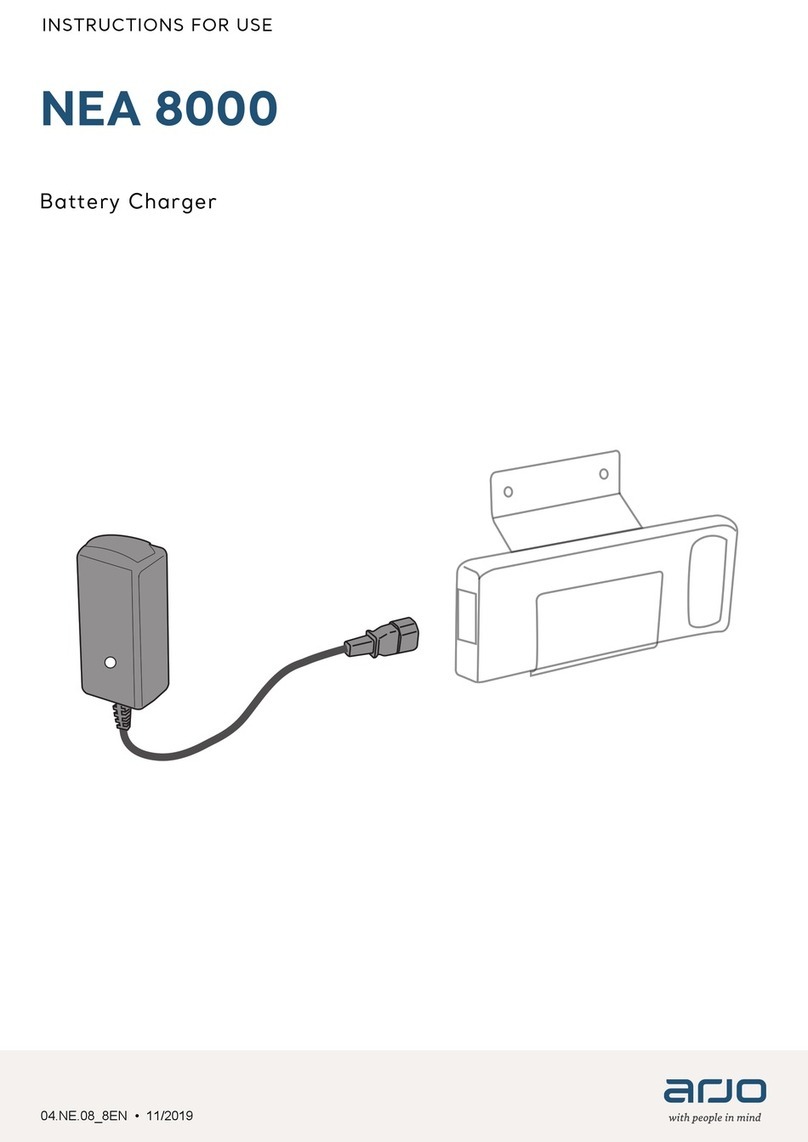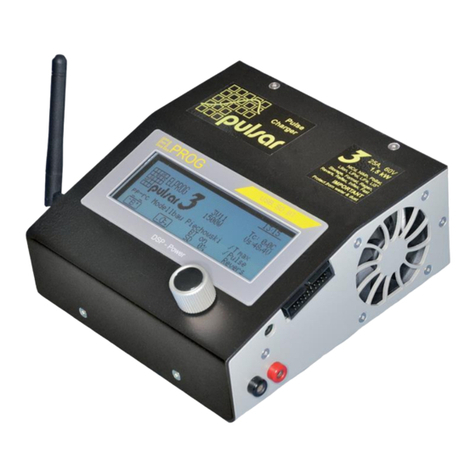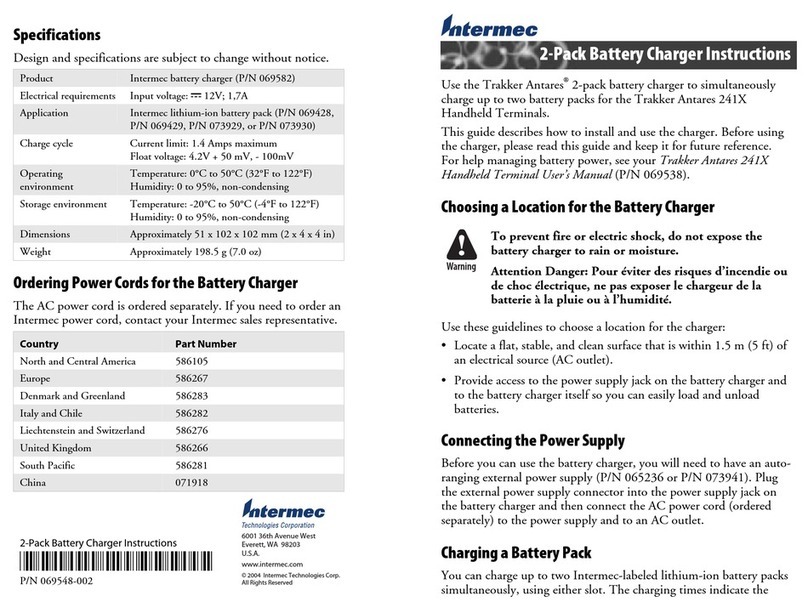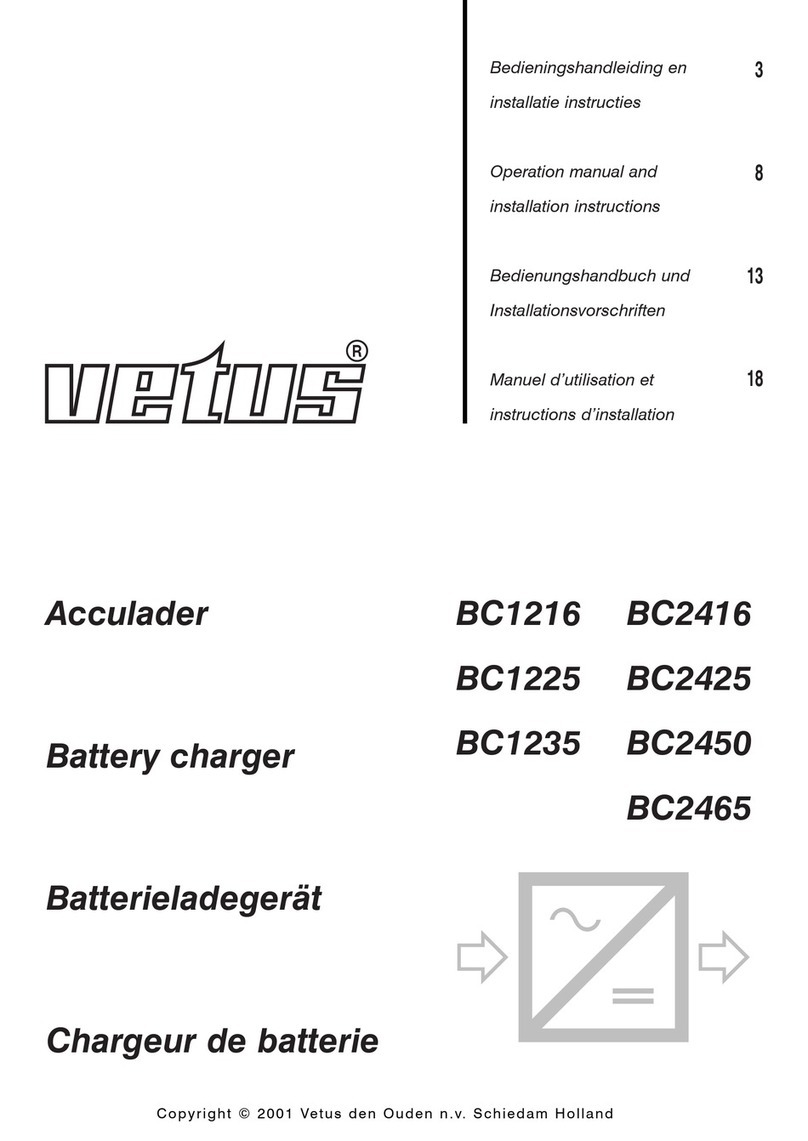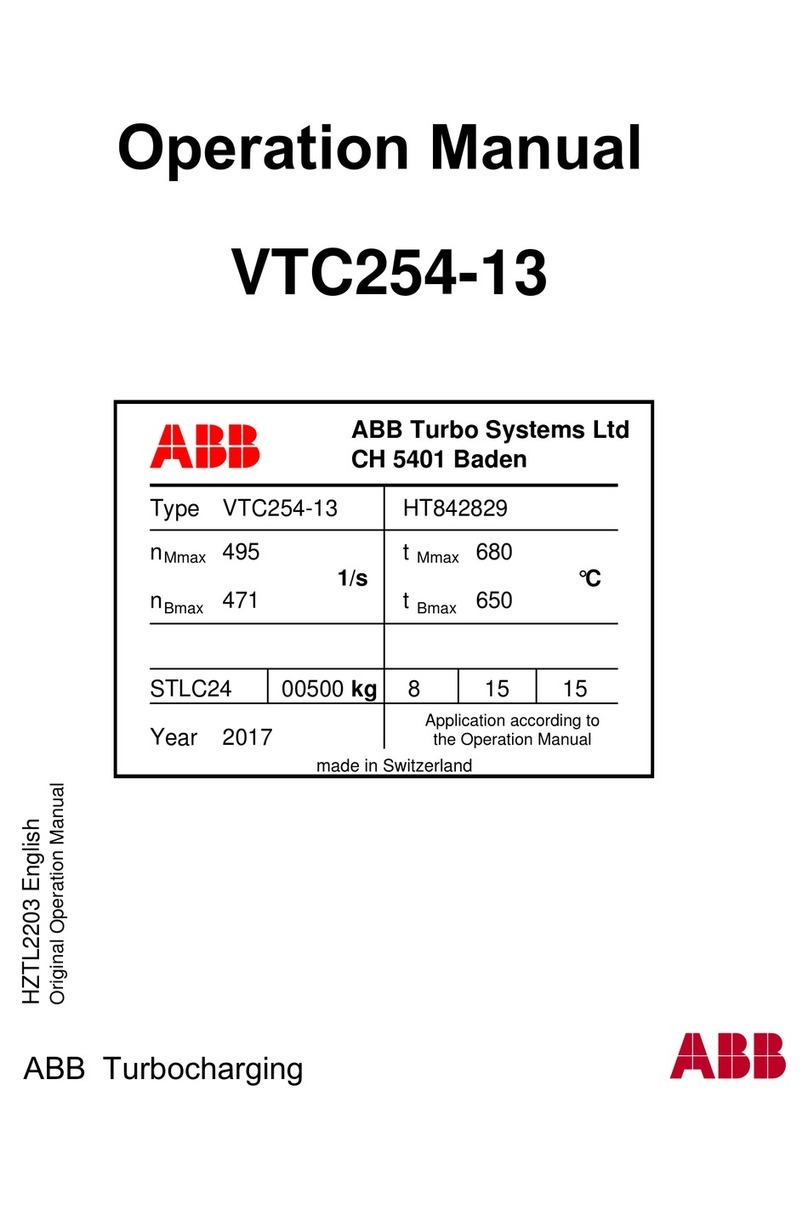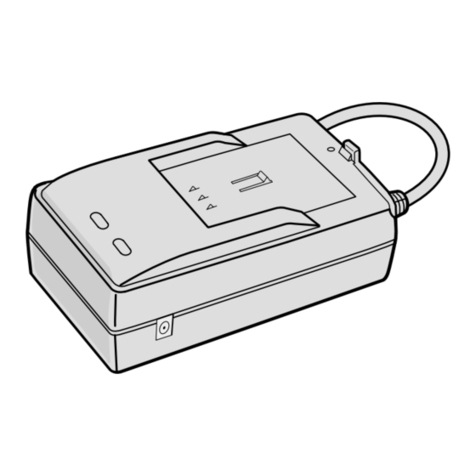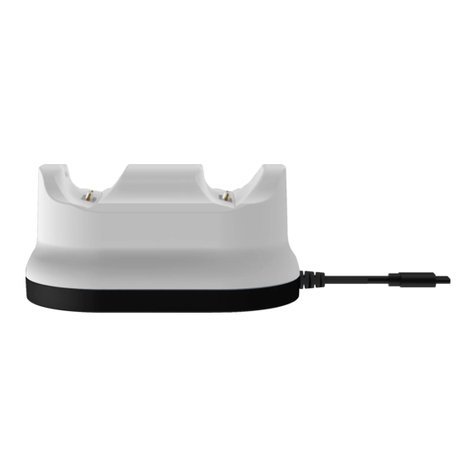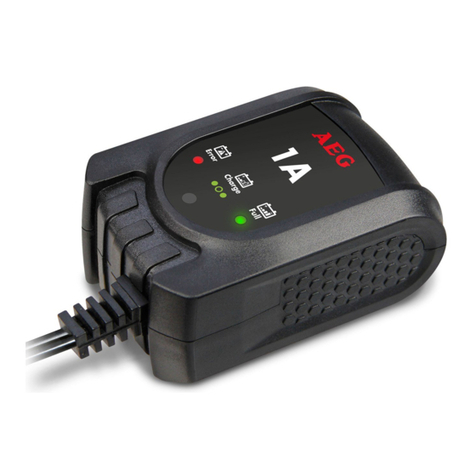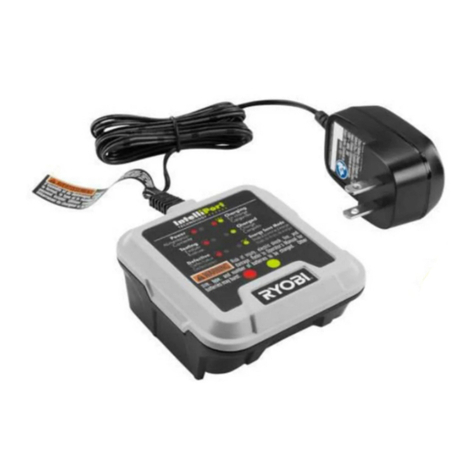BatteryMINDer BatteryMINDer 36271 User manual

Rev. A-051007 P/N VDC36271-MNL
BatteryMINDer® Model 36271
Page 1
INSTRUCTION MANUAL
BatteryMINDer®
Model 36271*
Maintenance - Charger /
Desulfator-Conditioner
Rev. A-051007 P/N VDC36271-MNL
VDC Electronics, Inc.
147 D Woodbury Rd.
Huntington, NY 11743
www.vdcelectronics.com
READ AND SAVE THESE INSTRUCTIONS
*NOT Designed to Replace Original
HIGH-OUTPUT Chargers - Use to
Maintain and Desulfate Lead Acid
Deep-Cycle Battery Systems
After
Fully Re-Charging ONLY

Rev. A-051007 P/N VDC36271-MNL
BatteryMINDer® Model 36271
Page 2
TABLE OF CONTENTS
Safety Instructions...................................................................................................................... 3
Preparing To Charge................................................................................................................... 5
Charger Location......................................................................................................................... 5
DC Connection Precautions....................................................................................................... 6
Qualifying Your Batteries.......................................................................................................... 8
Testing a Filler Cap Or Manifold-type Lead Acid Batteries..................................................... 8
Testing With A Hot/Cold Calibrated Hydrometer Tester.......................................................... 10
Testing Sealed, Agm Or Gelled-type Lead Acid Batteries..................................................... 10
Unit With Call-outs ..................................................................................................................... 12
Simplified Operating Instructions ............................................................................................. 13
LED Indicator Functions ............................................................................................................ 14, 15
Detailed Operation Instructions ................................................................................................ 16
Temperature Sensor ABS-248 (At-the-Battery Sensor).....................................................17, 21 - 23
Maintaining Multiple Batteries................................................................................................... 25
Battery Configurations .............................................................................................................. 26
Troubleshooting - Model 36271 ................................................................................................ 27
Detailed Specifications - VDC Model No. 36271..................................................................... 29 - 33
Charging Profile.......................................................................................................................... 34
For Repair Or Replacement....................................................................................................... 35
Guarantee And Warranty............................................................................................................ 36

Rev. A-051007 P/N VDC36271-MNL
BatteryMINDer® Model 36271
Page 3
Underwriters Laboratories (UL)
REQUIRED SAFETY INSTRUCTIONS
WARNING
TO REDUCE THE RISK OF FIRE,
ELECTRIC SHOCK, OR INJURY TO
PERSON, OBSERVE THE FOLLOWING:
1. Do not expose charger to rain or snow. It is
designed to operate ONLY INDOORS.
2. USE of any attachment not specifically recom-
mended by the battery charger manufacturer for
use with this exact model of charger may result
in risk of fire & electric shock or injury to person.
3. An extension cord should not be used, unless
absolutely necessary. Use of an improper exten-
sion cord could result in fire or electric shock. If
extension cord must be used be sure:
a. Pins on plug of extension cord are the same
number, size, & shape of plug on charger
b. Extension cord is properly wired and in good
condition.
c. Wire size is enough for AC ampere of charger
as specified below: Length of cord, feet (meters)
25 (7.6), 60 (15.2), 100 (30.5), 150 (45.6) AWG
Size #18.
4. Do not use charger if it received a sharp blow,
been dropped, or damaged.
5. Charger contains no serviceable parts. If it fails
for any reason, return to the address shown within
for a free replacement under warranty.
6. To reduce risk of electric shock, unplug charger
from outlet before attempting any cleaning.
7. WARNING - RISK OF EXPLOSIVE GASES.
WHENEVER YOU WORK NEAR A LEAD ACID
BATTERY IT IS DANGEROUS. BATTERIES
GENERATE EXPLOSIVE GASES DURING
NORMAL BATTERY OPERATION. FOR THIS
REASON, IT IS OF UTMOST IMPORTANCE
THAT EACH TIME BEFORE USING YOUR
CHARGER, YOU MUST READ THIS MANUAL
AND FOLLOW THE INSTRUCTIONS EXACTLY.

Rev. A-051007 P/N VDC36271-MNL
BatteryMINDer® Model 36271
Page 4
To reduce risk of battery explosion, follow these
instructions and those published by the battery
manufacturer and the manufacturer of any equip-
ment you plan to use in the vicinity of the batteries.
Review cautionary markings on the products and
the engine.
8. PERSONAL PRECAUTIONS when working
with or near a lead acid battery.
a. Someone should be able to hear your voice or
close enough to aid you when working near a lead
acid battery.
b. Have fresh water and soap nearby case battery
acid contact skin, clothing, or eyes. Wear com-
plete eye protection and clothing protection. Avoid
touching eyes while working near batteries.
c. If battery acid does contact skin or clothing,
wash immediately with soap and water. If acid
entered the eye, immediately ood the eye with
running water for at least 10 minutes and get help
immediately.
d. NEVER smoke or allow a spark of ame near
batteries or engine.
e. Be extra cautious to reduce risk of dropping a
metal tool or auto part onto battery. It might spark
or short circuit battery or other electrical part that
may cause an explosion.
f. Remove personal metal items such as rings,
bracelets, necklaces, and watches when work-
ing with a lead acid battery. A lead acid battery
can produce a short circuit current high enough to
weld a ring or the like to metal, causing a severe
burn.
g. Charger is designed to be used for recharging
lead acid batteries ONLY. Never use it to power a
low voltage electrical system, or for attempting to
recharge dry cell batteries that are commonly used
in house holds. These batteries may explode and
cause injury to persons and damage property

Rev. A-051007 P/N VDC36271-MNL
BatteryMINDer® Model 36271
Page 5
NEVER CHARGE A FROZEN BATTERY OR
ONE AT A TEMPERATURE ABOVE 123° F.
PREPARING TO CHARGE
a. If necessary to remove batteries from equip-
ment to charge. Always remove ground terminal
rst. Turn off all accessories in the vehicle, so as
not to cause an arc.
b. Be sure area around batteries is well venti-
lated while batteries are being charged. Force
gas vapors away by using a piece of non-metallic
material as a fan.
c. Clean battery terminals. Be careful to keep cor-
rosion from contacting eyes.
d. Add distilled water to each cell until battery acid
reaches level specied by the manufacturer. This
helps purge excessive gas from cells. Do not over-
ll. For a battery without caps, follow manufactur-
er’s recharging instructions.
e. Study all battery manufacturer’s specic instruc-
tions such as removing cell caps while charging
and recommended charge rates.
f. Determine condition of batteries, by referring
to instructions herein, before ever attempting to
charge or desulfate any / all batteries.
CHARGER LOCATION
a. Make sure charger is as far away from batteries
as output cables permit.
b. Never place charger directly above batteries
being charged; gases from batteries will corrode
and damage charger.
c. Never allow battery acid to drip on charger
when reading specic gravity or lling.
d. Do not operate charger in a closed-in area or
restrict ventilation in any way.
e. Do not set batteries on top of charger.

Rev. A-051007 P/N VDC36271-MNL
BatteryMINDer® Model 36271
Page 6
DC CONNECTION PRECAUTIONS
a. Connect and disconnect DC output clips from
batteries only after removing charger power cord
from outlet.
b. Attach clips to battery posts and twist or rock
back and forth several times to make good con-
tact. This tends to keep clips from slipping off ter-
minals and reduces risk of sparking.
FOLLOW THESE INSTRUCTIONS WHEN
BATTERIES ARE INSTALLED IN EQUIPMENT
(VEHICLE, PWC, BOAT, TRACTOR, ETC.)
A SPARK NEAR BATTERIES MAY CAUSE
BATTERIES TO EXPLODE. TO REDUCE RISK
OF A SPARK NEAR BATTERIES:
c. Position DC output cord to reduce risk of dam-
age by hood, door, covers, or moving engine
parts.
d. Stay clear of fan blades, belts, pulleys, and
other parts that can cause injuries.
e. Check polarity of battery posts. POSITIVE
(POS, P,+) usually has a larger diameter than
NEGATIVE -.
f. Determine which post of battery is grounded
(connected) to the chassis of equipment. If nega-
tive post is grounded see Item N. If positive post
is grounded see item P.
N. For negative grounded equipment, connect
POSITIVE (RED) clip from charger to POSITIVE
(POS, P, +) ungrounded post of battery. Connect
NEGATIVE (BLACK) clip to vehicle chassis or
engine block away from batteries. Do not connect
clip to carburetor, fuel lines, or metal body parts.
g. For positive ground equipment, con-
nect NEGATIVE (BLACK) clip from charger to
NEGATIVE (NEG, N,) UNGROUNDED POST OF
BATTERY. Connect POSITIVE (RED) CLIP to
chassis or engine block away from batteries.

Rev. A-051007 P/N VDC36271-MNL
BatteryMINDer® Model 36271
Page 7
DO NOT CONNECT CLIP TO CARBURETOR,
FUEL LINES, OR SHEET METAL BODY
PARTS.
Connect to heavy gauge metal part of frame or
engine.
h. When disconnecting charger, disconnect char-
ger from AC outlet, then remove clips from vehicle
chassis, and battery posts.
Operating instructions for charge information.
FOLLOW THESE STEPS WHEN BATTERIES
ARE OUTSIDE OF VEHICLE OR EQUIPMENT.
A SPARK NEAR THE BATTERIES MAY CAUSE
BATTERY EXPLOSION. TO REDUCE RISK OF
A SPARK NEAR BATTERIES:
a. Check polarity of battery posts. POSITIVE
(POS,P,+) usually has a large diameter than
NEGATIVE (NEG, N, -) battery post.
b. Connect (RED) charger clip to (POS+) post of
battery.
c. Position yourself and free end of cable as
far away from battery as possible, then connect
NEGATIVE (BLACK) charger clip to free end of
cable.
d. Do not face batteries when making final con-
nections.
e. When disconnecting charger, always do so in
reverse sequence of connecting procedure and
break first connection while as far away from bat-
teries as practical.
DO NOT ATTEMPT TO PERMANENTLY
INSTALL ANY CHARGER NOT SPECIFICALLY
DESIGNED FOR PERMANENT
INSTALLATION, ESPECIALLY IN A WET /
MARINE ENVIRONMENT

Rev. A-051007 P/N VDC36271-MNL
BatteryMINDer® Model 36271
Page 8
QUALIFYING YOUR BATTERIES:
Preliminary Requirements
NOTE: The BatteryMINDer has no electrical out-
put unless it is connected to healthy batteries.
Testing the BatteryMINDer with a volt or an Amp
meter without the unit being connected across
good batteries will result in a false reading. If you
experience any problems, or are not sure of how
to properly use or connect your BatteryMINDer,
please e-mail our technical support at:
free technical support line 800-379-5579 x206
(Eastern Time). Be certain to leave your phone
number with the area code, time zone and
the best time to call.
To gain the best result from your new charger and
to maximize the life and performance of your bat-
teries we strongly recommend you qualify (test)
your batteries before attempting to either charge-
maintain or desulfate them. Remember, even if
you just purchased “new” batteries they may have
been subjected to conditions that have caused
“sulfation” such as high temperature (>=80°).
NOTE: If your batteries are new and you
are certain they were not subject to con-
ditions that could have caused sulfation*,
even before you purchased them, you can
disregard our recommendations for qualify-
ing / testing your batteries, before using the
BatteryMINDer.
* Such as high temperature storage (=/> 80°F)
and/or allowed to self-discharge to 12.4 Volts or
lower (6.2-V for 6-Volt batteries.)
Testing a Filler Cap or Manifold-type Lead
Acid Batteries. Set Charger to Flooded
Mode.
1. Carefully remove all caps or manifold-type
covers from your batteries.
2. Check the water-liquid electrolyte level. If
the level is low or has ever been below top of
plates, severe lead plate sulfation has taken place.
Significant recharge/reconditioning time is needed
to restore these plates to a condition where the
batteries can be expected to function normally.

Rev. A-051007 P/N VDC36271-MNL
BatteryMINDer® Model 36271
Page 9
3. Refill each cell with distilled water only to the
liquid level indicator found in each cell. Before
proceeding further you must be thoroughly
familiar with the safety and operating instruc-
tions.
4. Recharge the batteries with the BatteryMINDer
to ensure that they are slowly and completely
charged before you determine their condition.
Allow each battery to “rest”* overnight for a mini-
mum of 12 hours before testing with a tempera-
ture compensated hydrometer and/or digital type
voltmeter only.
* “RESTED” = batteries that have been as
fully charged as possible, using a 3 stage
charger (model 36271) and left disconnected
from charger or any type load for a minimum
of 12 hours.
5. If the BatteryMINDer battery condition LED
lights (YELLOW) within 72 hours or no balls float
in one or more cells, battery may be too far gone
to be fully desulfated. Reconnect battery to your
BatteryMINDer and press the Maintenance mode
button. Allow batteries to remain in maintenance
mode for a minimum of 72 hours, before re-test.
Use a hot/cold calibrated hydrometer tester for
the most accurate results** (see next page) if you
see an increase in the Specific Gravity (SG) or
voltage indicating that there is an improvement in
the battery’s condition, continue desulfating for
an additional 72 hours and retest. Continue this
process until the SG or voltage readings no longer
increase.
Temp. Compensated Hydrom-
eter - meter or 4 ball type
Full Capacity
Percentage
1.270 (4 Balls oating) 100%
1.250 (3 Balls oating) 75%
1.190 (2 Balls oating) 50%
1.150 (1 Balls oating) 25%
1.120 (0 Balls oating)
May denote shorted cell or
battery that has been severely
discharged and may not be
recoverable
0%
Specific Gravity – Capacity
TABLE 1

Rev. A-051007 P/N VDC36271-MNL
BatteryMINDer® Model 36271
Page 10
Testing with a Hot/Cold Calibrated
Hydrometer Tester
Read the tester instructions carefully for most
accurate readings.
1. When using the tester the first time or after a
long period of non-use, fill the tester with the bat-
tery fluid and let it sit for 1/2 hour or longer. This
will soak the balls in order to give you more accu-
rate readings. Failure to do so will give you false
readings indicating a battery that may not be in as
good a condition as you may have thought.
2. After inserting the tester in a cell, gently tap the
tester several times against the inside wall of each
cell to dislodge air bubbles that will cause more
balls to float than should. Failure to do so will yield
false readings that indicate a battery that is not
fully desulfated or does not qualify for desulfation.
3. If no balls float in any cell, the cell is shorted.
This means your battery is beyond the point of
being properly recharged or reconditioned-desul-
fated. Dispose of the battery.
If each cell floats three (3) or more balls (or 1250
on gauge-type), your battery can be desulfated-
reconditioned.
4. Always rinse the tester with fresh water after
every use. Failure to do so will cause false read-
ings.
Testing Sealed, AGM or Gelled-type
Lead Acid Batteries
These batteries have no filler caps or manifold-
type covers. Because you cannot gain access to
the interior of your battery you cannot test it with a
hydrometer.
Testing Using a Digital Voltmeter:
1. Recharge batteries with the BatteryMINDer to
ensure they are as completely charged as possi-
ble, before you determine its condition. Allow bat-
teries to “rest” (see pg. 9) overnight for a minimum
of 12 hours before testing with a digital voltmeter
only.

Rev. A-051007 P/N VDC36271-MNL
BatteryMINDer® Model 36271
Page 11
Failure to test “rested” (see pg. 9) batteries will
cause false readings. Be certain to read and
understand all safety related instructions (pages 3
to 7) before proceeding further.
2. Measure battery voltage, without any load
attached. If the voltage is less than 37.2 volts
(Typically 50% of charge) the battery may be too
heavily sulfated to be fully recoverable. If voltage
is 37.2-V or higher full recovery can be expected,
given sufficient time (average 1-2 weeks for batter-
ies that are heavily sulfated).
3. Connect the BatteryMINDer to the batteries.
4. Charge batteries to their maximum level. Allow
batteries to remain for a minimum of 72 hours
before retesting. If improvement is seen, continue
until battery voltage reaches full capacity level or
no further increase is seen.
OCV - “Rested”
Voltage
Full Capacity
Percentage
38.7 - 39.3 Volts 100%
37.8 - 38.7 Volts 75%
37.2 - 37.8 Volts 50%
36.6 - 37.2 Volts 25%
36.0 - 36.6 Volts 0%
<33 Volts
= shorted
OCV=Open Circuit No Load Voltage
TABLE 2

Rev. A-051007 P/N VDC36271-MNL
BatteryMINDer® Model 36271
Page 12
1
10
9
8
64
5
3
2
11
1) Battery clip cordset w/ qwik connect plug (pgs.13, 16)
2) Ring terminal cordset w/ qwik connect plug (pgs. 13, 16)
3) Mounting tabs
4) Input power cordset (pg. 13, 18)
5) Output cord w/ qwik connect plug (pg. 13, 16)
6) Temperature sensor input connector (pg. 13, 17, 21)
7) n/a
8) Battery type selection button (pgs. 13, 17, 18)
9) Start / reset / stop selection button (pgs. 13, 17, 18)
10) LED indicators for power, connection, fault, battery
condition, charge status (pgs.13-15, 18–20, 23)
11) Temperature sensor with cord and ring terminal (pgs. 17,
21 - 23)

Rev. A-051007 P/N VDC36271-MNL
BatteryMINDer® Model 36271
Page 13
Simplified Operating Instructions
(Read and thoroughly understand ALL SAFETY Instructions on pages (3-7) and Qualifying Your
Batteries pages 8-11, BEFORE proceeding further.
1. Attach a battery connector assembly (supplied) to output cordset of charger, either the clips or ring termi-
nal assembly, - NEVER BOTH at same time. (See diagrams - Page 26)
2. Attach output to battery terminals-RED band =Positive + BLACK band = Negative.
2-a: Attach temperature sensor ABS-248 to batteries and then to charger*. (See Page 21)
3. Plug AC power cord into 120 Vac electrical outlet. Observe REVERSED Polarity LED indicator. If lit RED,
reverse battery connector attachments on battery.
4. Observe Battery Connected - Error Indicator, LED Must be lit GREEN**
5. Charger will automatically start in Gel and 2.7 Amp modes when first plugged into 120 Vac
power. Restart and reset to correct modes, if required.
6. Select Correct battery type: Flooded (wet-filler caps or manifold, Sealed AGM (“dry”) or Sealed Gel ***
7. Observe GREEN LED indicator labeled Charge-Float = Solid when charging, Blinking when maintaining
batteries.
IF IN DOUBT REGARDING ANY OF THE ABOVE, REFER TO FULL INSTRUCTIONS
* See detailed instructions for need and method of properly connecting sensor to batteries, pgs. 21 - 23.
** See full instructions if not lit GREEN.
*** IMPORTANT If in doubt about what type, consult with seller or manufacturer of batteries, before going
further. Choosing the wrong setting will cause over or under charge, leading to shortened battery life or
generating potentially hazardous hydrogen gas.

Rev. A-051007 P/N VDC36271-MNL
BatteryMINDer® Model 36271
Page 14
Battery Condition Indication
Battery connected before charge:Vb<33V YELLOW
Vb>33V GREEN
If Reset Button is pressed in the charging stage MAINTAINS PREVIOUS STATUS
Battery sulfation checked: Vb<38.4V YELLOW
Vb>38.4V GREEN
LED INDICATOR FUNCTIONS -- Tables 3 (top) and 4 A&B (bottom)
LED Status - (Battery Connect / Error and Charge LEDs) CONNECT / ERROR CHARGE - FLOAT
GREEN RED GREEN
A.C. power disconnected, battery connected correctly OFF OFF
A.C. power connected, battery connected GREEN OFF
A.C. power connected, battery connected (press start button) GREEN ON
At Soft Start mode, Bulk charge mode, Absorption mode GREEN ON
In Sulfate check mode Float charge mode GREEN FLASH
A.C. power connected Reversed Battery Polarity RED ON OFF
A.C. power connected, charger output Clip shorted RED ON OFF
A.C. power connected, battery voltage is less than 9V RED ON OFF
Timed-out when in SoftStart or Bulk mode RED FLASH OFF
Timed-out when in Mode A, Mode C, Absorption mode RED FLASH FLASH
Absorption mode Thermal Run away RED FLASH OFF

Rev. A-051007 P/N VDC36271-MNL
BatteryMINDer® Model 36271
Page 15
9LL=JQ'#(=J¸
Charger / Maintainer /
Full Time De-Sulfator - Conditioner
36-Volt @ 2.7 Amp
Model 36271
2.7 A AGM
GEL
FLOODED
Select
Battery Type
Green = Battery Connected
ERROR:
Red = Polarity Reversed
/ Battery = less than 9-Volts*
Red (Blinking) = Battery Fault / Battery Weak*
Charge - Float
Green (solid) = Charging
Green (blinking) = Float (maintenance)
*See Instruction Manual
PRESSPRESS
Battery Condition Indication
Power On & Battery Connected
Before Start Charge:
Green = OK - Accepted
Yellow = Weak / Sulphated / Deep Discharge*
After Charge:
Green = Good
Yellow = Sulphated / Weak*
MAINTENANCE
MODE ONLY
(HOLD 3 SEC.)
U.S. Patents: 5783929 & 6078166
Start / Reset
/ Stop
VDC Electronics, Inc.
800-379-5579 (ET)
www.vdcelectronics.com
Hold for 5 sec. for full reset
RED RED RED
AGM Flooded Gel
AGM ON OFF OFF
Flooded OFF ON OFF
Gel OFF OFF ON
GREEN
2.7A
ON
LED INDICATOR FUNCTIONS
LED indicators refer to charger label at right
TABLE 5
TABLE 6

Rev. A-051007 P/N VDC36271-MNL
BatteryMINDer® Model 36271
Page 16
Detailed Operation Instructions Model 36271
After carefully reading and understanding the
Safety Instructions contained in this manual
(pages 3 to 7) and having evaluated your batteries
as described in Qualifying Your Batteries (pages
8 to 10) you are properly prepared to begin using
your charger.
1. Attach output cord of charger to either the
Battery Clip(s) Assembly (BCA) (supplied) or the
Ring Terminal Assembly (RTA) (supplied) depend-
ing on your preference. However never use both
assemblies at the same time for any reason what-
soever.
Never use either of these assemblies on any
other charger or for any other purpose such
as improvised “jumper cables”, etc.
Using the RTA on batteries remaining in their nor-
mal use location (in same place they are regularly
installed will normally prove the safest and most
convenient. If you have several applications you
may wish to purchase additional Ring Terminal
Assemblies (RTA) available from your dealer or
VDC Electronics, Inc. directly.
Note: this assembly contains a 15 Amp auto-
motive type fuse and is replaceable should
for any reason it were to blow. Never replace
this fuse with any type whose rating is higher
than 15 Amps, as seriously harmful results
may occur.
2. Identify the positive and negative posts or con-
nections on your batteries, usually clearly des-
ignated with the polarity markings of + (positive)
and – (negative)*. If you have previously installed
the RTA referred to in 1. above, you need only to
press the connector plug of the charger’s output
cord into the mating plug of the RTA. Push firmly
and do not leave any space between them.
*See diagrams on Page 26.

Rev. A-051007 P/N VDC36271-MNL
BatteryMINDer® Model 36271
Page 17
Correct polarity and a good connection will be
your reward. Attach the BCA to the proper bat-
tery posts, clamps or screw terminals, depending
on type of battery.
ALWAYS
connect the nega-
tive (Black) clip to a metal grounding point
(Negative ground installations such as most
golf cars, modern cars, trucks, boats, RVs,
etc.) as far away from battery as possible for
maximum safety. Never connect to any type
of fuel line.
Note: Older vehicles or other devices may be
Positive ground installations
requiring differ-
ent connection recommendations. If unfamiliar or
unsure which battery type of grounding system
you have, check with our Tech Support personnel
before proceeding further.
Note: Temperature compensation Sensor
Assembly (Part# ABS-248).See pages 21 - 24
for full detailed instructions.
3. Determine the type of battery you wish to
charge. When certain press the Select Battery
Type button. The most common is the Flooded
kind, distinguished by removable filler caps or
manifold covers (Maintenance-Free) which should
not be removed unless specifically allowed by the
battery manufacturer. The second most popular
is the Absorbed Glass Mat (AGM) sealed-valve
regulated type. Lastly is the sealed valve regulated
Gel battery.
Note: If unsure of your battery type, check with the
battery seller, manufacturer or our Tech Support
before proceeding further. The normal (default)
setting of your charger is GEL, as this is the low-
est voltage output and thus the one least likely to
cause your battery to be overcharged, should
you incorrectly select the wrong battery type.
However be aware that using the wrong set-
ting for a particular type battery can dramatically
shorten its life and/or cause potentially explosive
gas to be emitted from the battery.

Rev. A-051007 P/N VDC36271-MNL
BatteryMINDer® Model 36271
Page 18
4. After selecting both battery type and charge
rate, plug the unit’s Power cord into a standard
– grounded 120 Vac electrical outlet. The Battery
Connected LED Indicator will light GREEN. If it
does not light GREEN check the outlet to be
sure it is functioning. In addition, be sure if outlet
is controlled by a switch, no one will accidentally
shut off the power to the outlet. Check for cor-
rect polarity = (no ERROR RED LED Indicator). If
ERROR Indicator is lit, reverse the charger’s out-
put connections to the batteries.
5. Press the Start / Reset / Stop button. The
Charge – Float LED Indicator will light GREEN.
The charger will now begin charging by first
checking the battery to determine its voltage and
ability to accept a charge. Should the batteries
not have a normal fully discharged voltage (31.5-
V minimum) the unit will begin charging in the
“Soft-Start” mode to determine if batteries can be
safely charged. If it cannot, the Battery Connected
– Error LED will flash RED and charging will be
stopped. Batteries should be carefully checked
under a load by a qualified person before further
attempting to charge it.

Rev. A-051007 P/N VDC36271-MNL
BatteryMINDer® Model 36271
Page 19
Note: If the battery system does not have
a minimum no load OCV (Open Circuit
Voltage) of 33 volts, the ERROR LED will
light RED and charger will reject batteries.
No further effort should be made to charge this bat-
tery with this charger or any charger. Discard this
battery, unless it has just been subjected to a long
period of continuous discharge under a load such
as can occur with leaving lights on or cranking an
engine excessively. Allow such a battery to “Rest”
for several hours (overnight if possible) before
determining if it is defective. Be very suspicious of
any 36-V battery system that does not have at least
33-Volts (OCV) before it is recharged. It may well be
seriously damaged and unsafe for any type of use or
recharge. The unit’s Battery Condition Indication LED
will help you determine if batteries are less than 33-
Volts (YELLOW)) or greater than 33-Volts (GREEN)
7. After batteries have been fully charged, the
GREEN Charge-Float LED Indicator will begin
blinking. It will continue to blink indefinitely, unless
unit is disconnected from batteries or Start / Reset /
Stop button is pressed. Should batteries be unable
to be fully charged, the LED will not blink and the
RED Error LED will blink. Batteries may not be
able to be fully charged, may be too large or too
deeply discharged to be fully charged in the normal
time allowed by charger. If you are certain one or
more batteries are not defective, having read and
understood completely all of the above concerns
and conditions, proceed to restart the charger by
pressing and holding the Start/Reset/Stop but-
ton for approx. 5 seconds until all LEDs Flash.

Rev. A-051007 P/N VDC36271-MNL
BatteryMINDer® Model 36271
Page 20
If batteries are not defective they should be able
to be fully charged after being restarted. After suf-
ficient time has lapsed the GREEN charge LED
Indicator will blink confirming when / if batteries
are now fully charged.
After carefully reading these instructions and
Troubleshooting (pgs. 27 - 28) sections, should
you still have questions, please e-mail our techni-
cal support department at:
Allow up to 3 business days for a detailed
response to your questions. Always identify the
model number of the product and revision letter of
this manual contained on this page below. Without
this information we may not be able to assist you
correctly.
If your questions have already been answered in
this manual you can expect a response referring
you back to this manual and the specific page(s).
Other manuals for BatteryMINDer 36271
1
Table of contents
Other BatteryMINDer Batteries Charger manuals
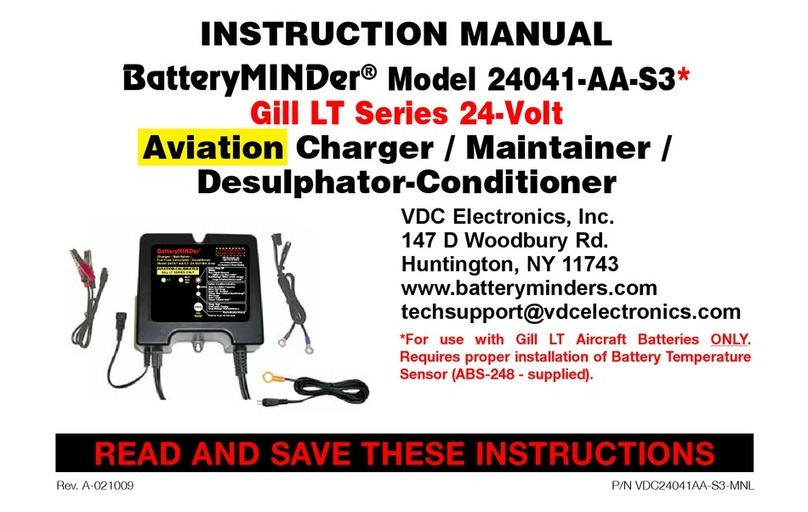
BatteryMINDer
BatteryMINDer 24041-AA-S3 User manual
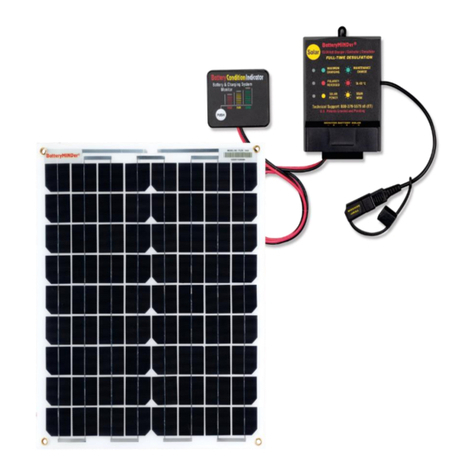
BatteryMINDer
BatteryMINDer SCC1224 User manual
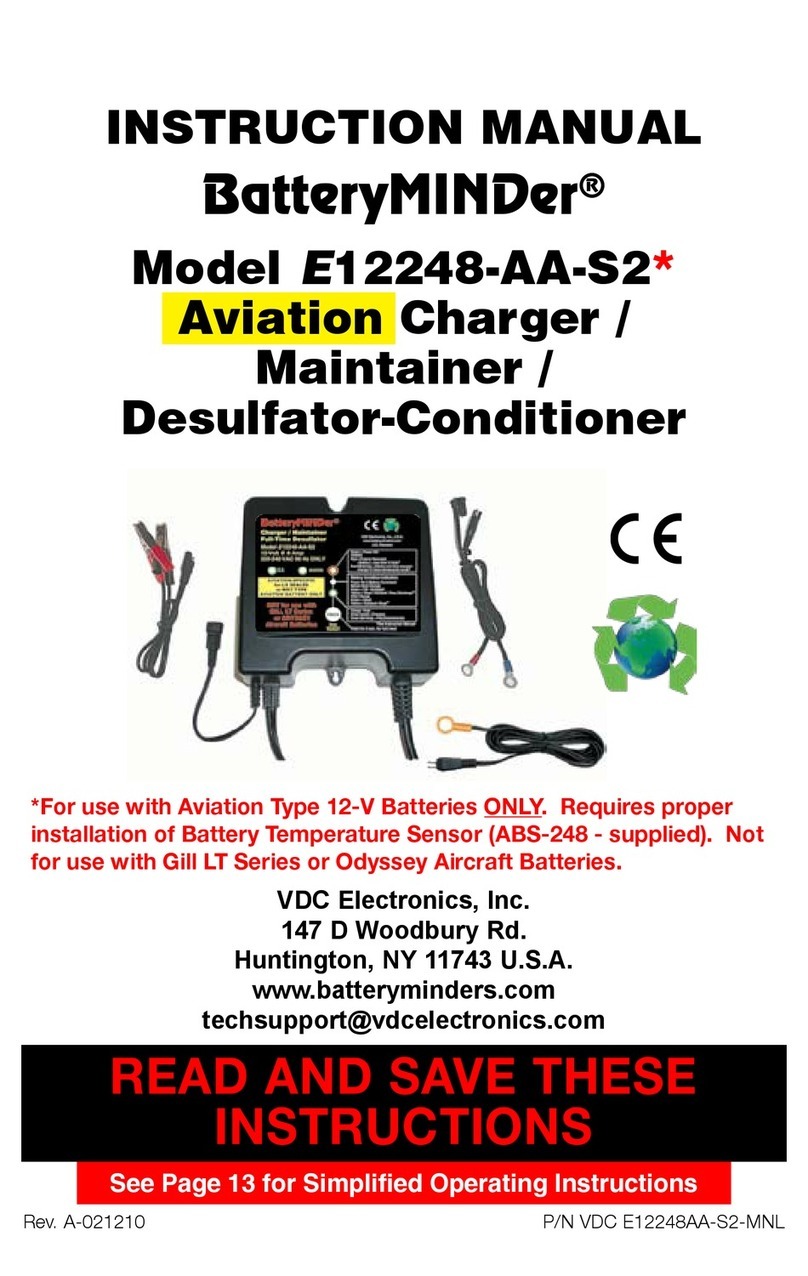
BatteryMINDer
BatteryMINDer E12248-AA-S2 User manual
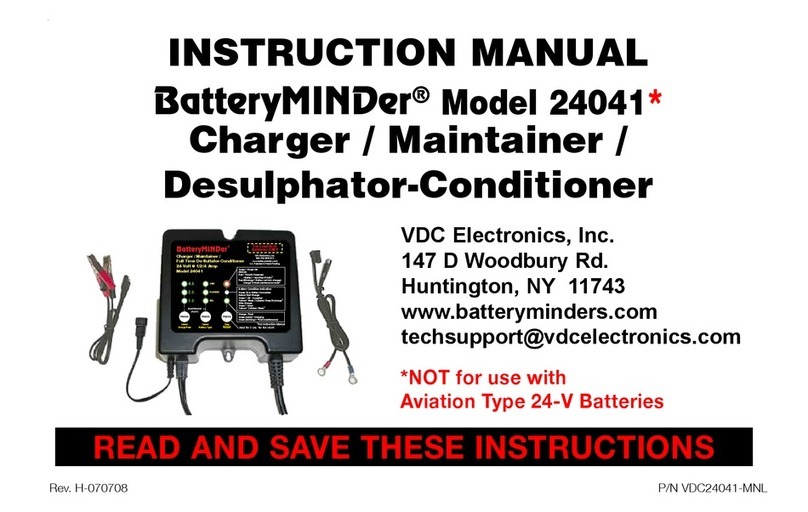
BatteryMINDer
BatteryMINDer 24041 User manual
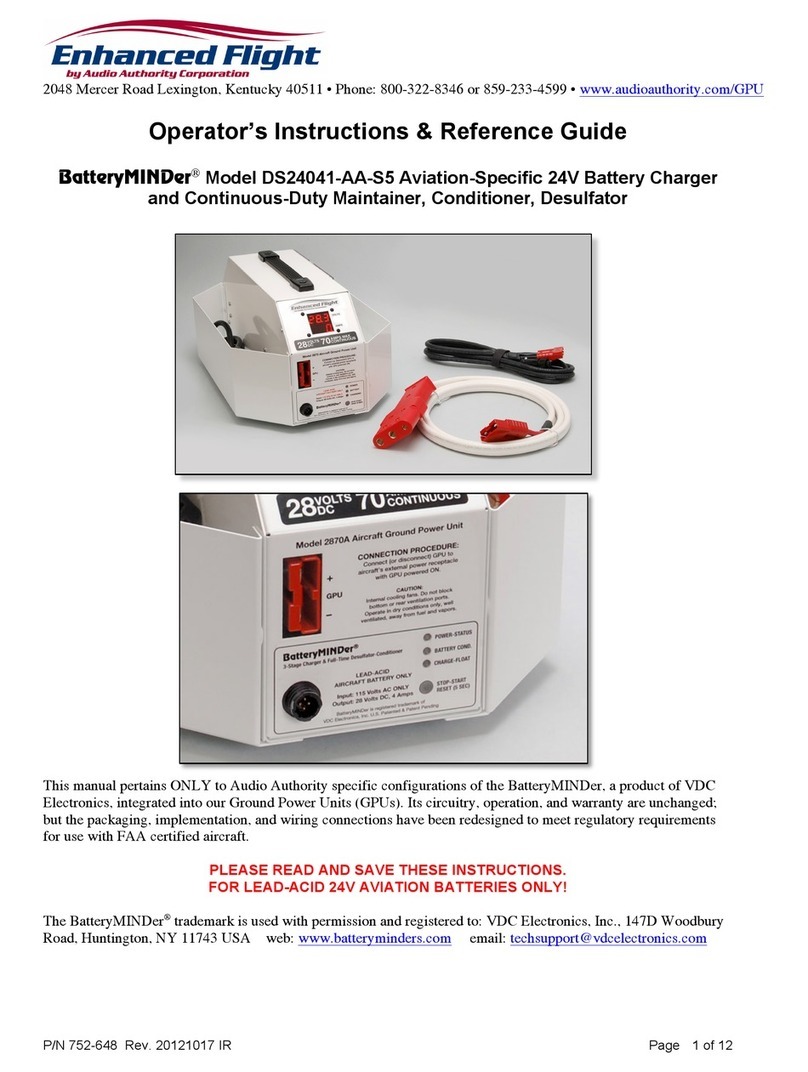
BatteryMINDer
BatteryMINDer DS24041-AA-S5 Specifications
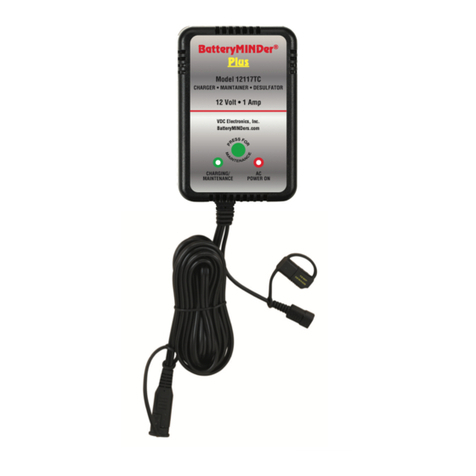
BatteryMINDer
BatteryMINDer Plus 12117TC User manual
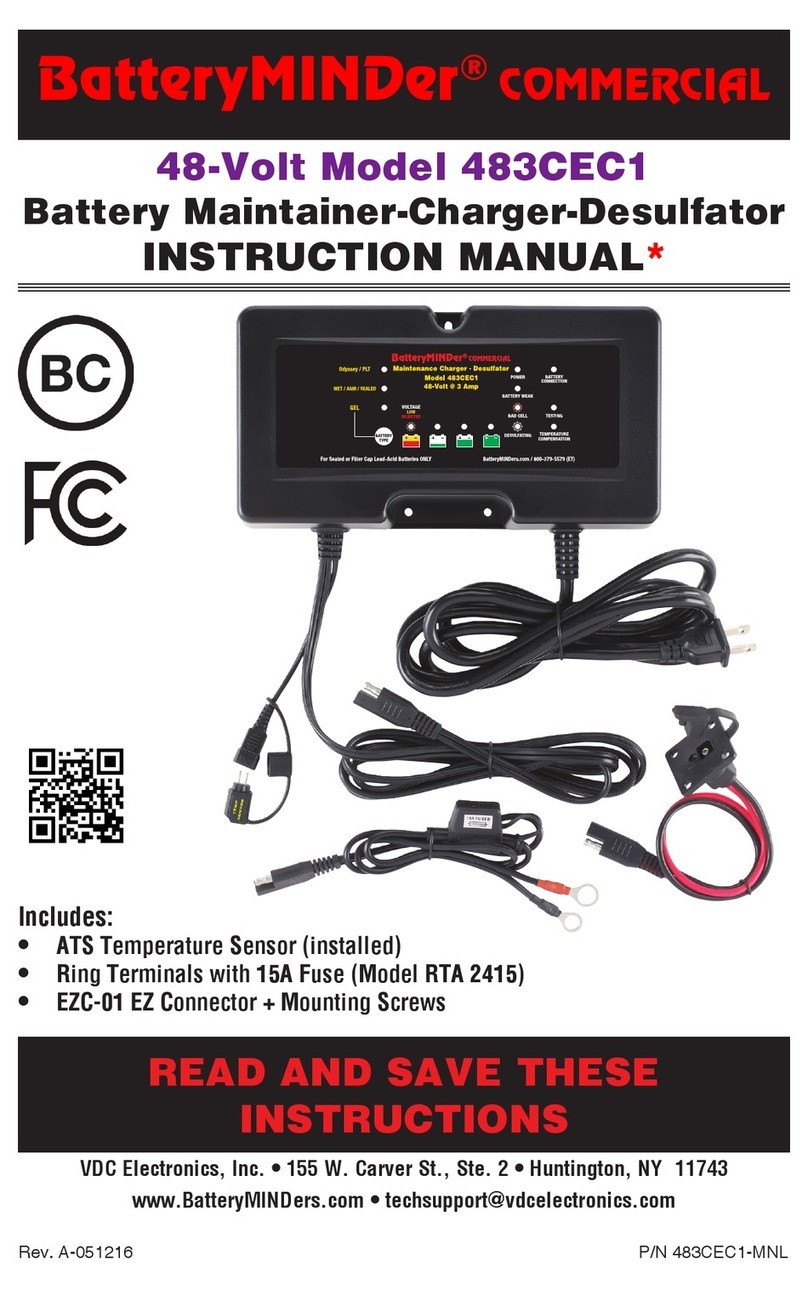
BatteryMINDer
BatteryMINDer 483CEC1 User manual
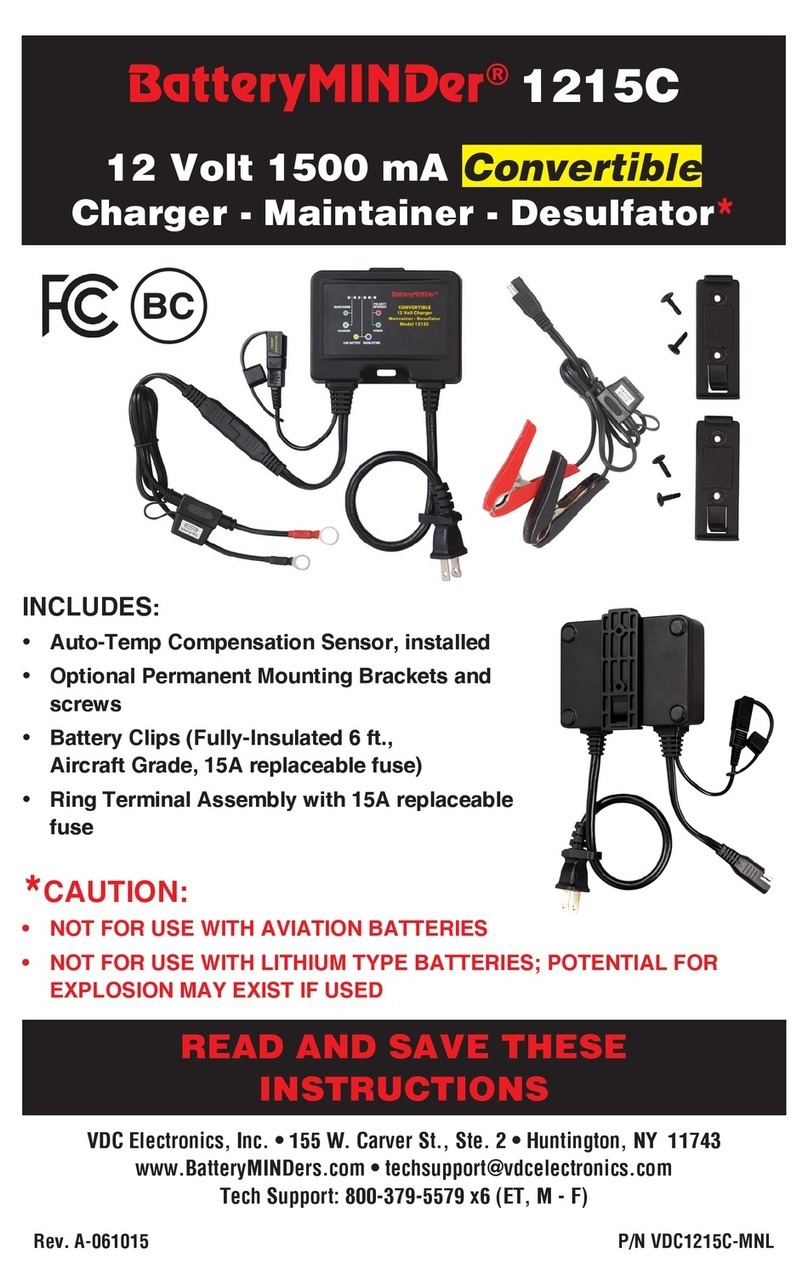
BatteryMINDer
BatteryMINDer 1215C User manual
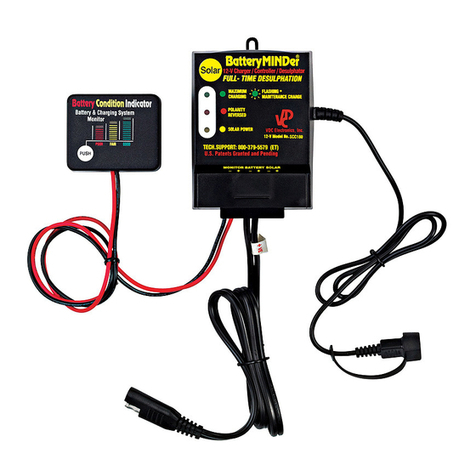
BatteryMINDer
BatteryMINDer SCC180 User manual

BatteryMINDer
BatteryMINDer 128CEC1 User manual
